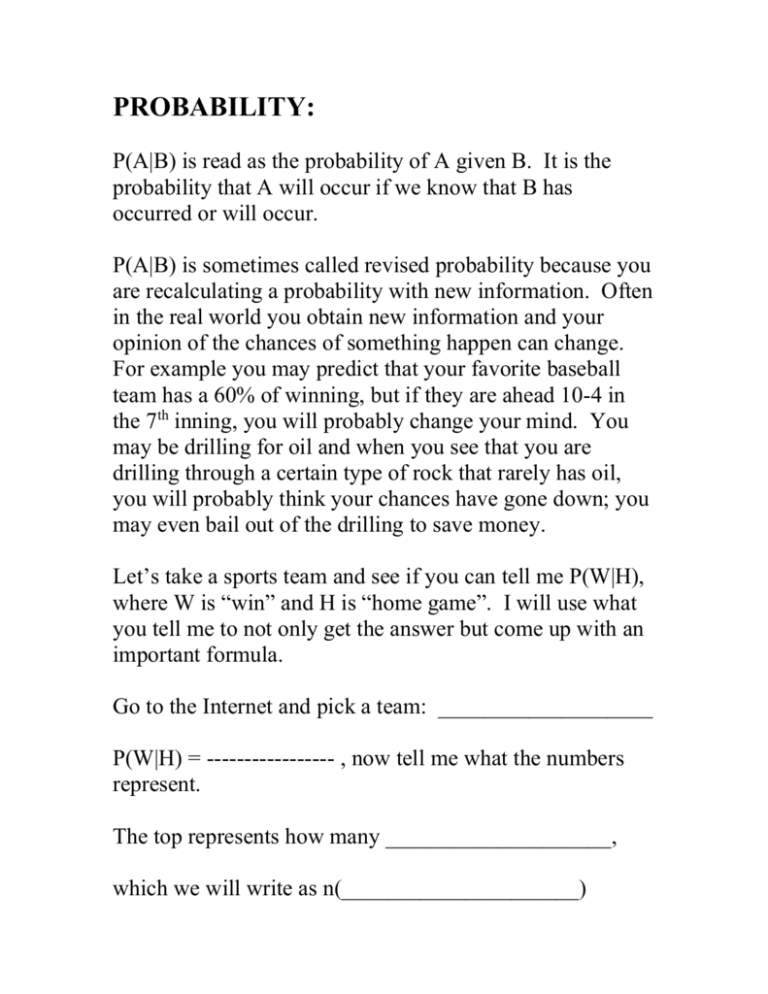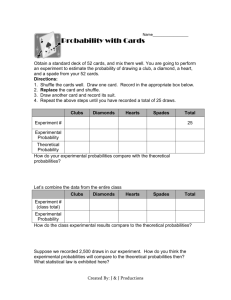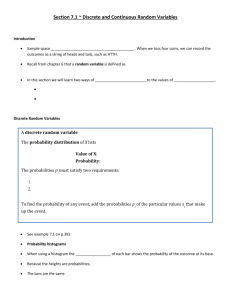probability - Colorado Mesa University
advertisement

PROBABILITY: P(A|B) is read as the probability of A given B. It is the probability that A will occur if we know that B has occurred or will occur. P(A|B) is sometimes called revised probability because you are recalculating a probability with new information. Often in the real world you obtain new information and your opinion of the chances of something happen can change. For example you may predict that your favorite baseball team has a 60% of winning, but if they are ahead 10-4 in the 7th inning, you will probably change your mind. You may be drilling for oil and when you see that you are drilling through a certain type of rock that rarely has oil, you will probably think your chances have gone down; you may even bail out of the drilling to save money. Let’s take a sports team and see if you can tell me P(W|H), where W is “win” and H is “home game”. I will use what you tell me to not only get the answer but come up with an important formula. Go to the Internet and pick a team: ___________________ P(W|H) = ----------------- , now tell me what the numbers represent. The top represents how many ____________________, which we will write as n(_____________________) The bottom represents how many ____________________, which we will write as n(_____________________) So far we have: P(W|H) = --------------------------------. Next we would like to change the n’s (how many) into probabilities. How can we do this? Example: Suppose I make 60 free-throws. How can you turn the how many free-throws made into an estimate of the probability I can make a free-throw? We will do this to both the top and bottom of our fraction. (Dividing the top and bottom of a fraction by the same number does not change its value.) So we have P(W|H)=--------------------- = --------------------It is more common to use the letters A and B, so if we rewrite this we get the important formula. P( A | B) P( AandB) P( B) Note that if P(A|B)=P(A) that this says that B has no affect on the chances of A. If this happens as well as P(B|A)=P(B) then we call A and B independent. If W=”a sports team wins” and H=”they play at home”, then these are probably NOT independent since most likely P(W|H) is not the same as P(W). P(W|H) is probably _________. If W=”a sports teams wins” and D=”the sports casters for the game didn’t get their favorite donuts in the sports cast booth before the game”, then these are probably independent since P(W|D) and P(W) are most likely __________. If we take this important formula and multiply both sides by P(B) we get P(B)P(A|B) = P(A and B) We will see that this has a nice picture that we can use in place of the formula. Below is a tree diagram showing all the possibilities of A and B occurring or not occurring. Note that tree diagrams can be draw with more than two subdivisions such as rolling a die in which you could have 6 subdivisions. B or not B comes first only because of the way the formula was written on the previous page. In the tree diagram we will fill in probabilities in the most natural way (formulas not numbers) along each branch and at the end. Note that if you multiply the numbers on each branch you get the result at the end. This works for all paths and agrees perfectly with the formula from the previous page P(B)P(A|B) = P(A and B) for the top path. So it is not necessary to use this formula, we can draw a tree diagram and multiply the probabilities on the branches. Plus drawing the tree diagram gives a picture for our mind to help understand the problem. This is called a Venn Diagram. Note there are four regions giving all the possibilities of A and/or B occurring just as there are four paths in the Tree Diagram on the previous page. Place the four probabilities of the paths in the tree diagram in the natural places in the Venn Diagram. These four probabilities must add up to __________. We would like the two probabilities in the A circle to add to the probability of A. We would like the two probabilities in the B circle to add to the probability of B. Since these four probabilities are the same as the four probabilities of the paths in the tree diagram. The probabilities at the ends of the paths also add. Note that it is easy to have a Venn Diagram with three outcomes. It is also possible with more than three but the diagram is messy and hard to draw. Example: Suppose 1% of people tested have a certain disease and a test is developed to test for this disease. Suppose the test is 99.7% accurate on those that actually do have the disease and 99.2% accurate on those that do not. Can you find out for sure if you have the disease? Is testing + the same as having the disease? What can you find out for sure? Find P(having the disease | +) and P(having the disease | -). How do you feel about telling a patient they have the disease if they test +, how do you feel about telling the patient they do not have the disease if they test -? How do you fix this problem? Why did this happen? (Maybe you were expecting P(having the disease | +) to be higher) How do we really know if a person has the disease? Conditional probability is sometimes used in the following misleading way. In sports for example if a team is ahead by a couple points at half time the announcers might say the team wins 90% of their games when they are ahead at halftime. However, this takes into account all games in which they are ahead at halftime, including when they are ahead by a lot. In this case we are not using all the information given. Note the announcers rarely make this comment when the team is way ahead, only when its close. To illustrate that P(A|B) and P(B|A) are different consider the example M=”person has used marijuana” and T=”person has used meth”. It is probably the case that P(M|T) is much ________ than P(T|M). People that are against marijuana may try to report P(M|T) to show that marijuana is a gateway drug to meth, but it is probably more appropriate to look at P(T|M). This is the case since P(B|T) where B=”person has had a hamburger sometime in their life” is close to 100%, so hamburgers may be the gateway to meth!








